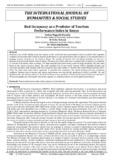Bed Occupancy as a Predictor of Tourism Performance Index in Kenya

View/
Date
2020-10Author
Mwamba, Nathan Mugambi
Muhanji, Stella
Kipchumba, Simon
Metadata
Show full item recordAbstract
Tourism is one of the leading economic engines in the world and most governments invest in policies that engender
conducive environment that enhances tourism performance in such governments. Bed occupancy is one measurement of
gauging tourists’ attraction to the hotels in Kenya. The number of tourists who visit Kenya annually can also be a
measure of tourist performance index in Kenya. The main aim of this study was to analyze bed occupancy as a predictor
of Tourism Performance Index in Kenya. The study adopted descriptive survey research design targeting 183 star rated
hotels in the tourist circuit in Kenya. The study sampled 126 of such hotels Yamane (1967) sampling formula and
extracted secondary data dealing with bed occupancy and total number of tourists who visited Kenya between 20132019.
The study used simple linear regression to establish this prediction. The results indicate that the correlation
coefficient between bed occupancy and tourist performance was statistically significant (r=0.622, p=0.000). The null
hypothesis Ho
1:
that bed occupancy in the hotels in Kenya is not a predictor of tourist performance Kenya was rejected at
.05 level of significance. This implies that bed occupancy is a reliable predictor of tourist performance Kenya.
